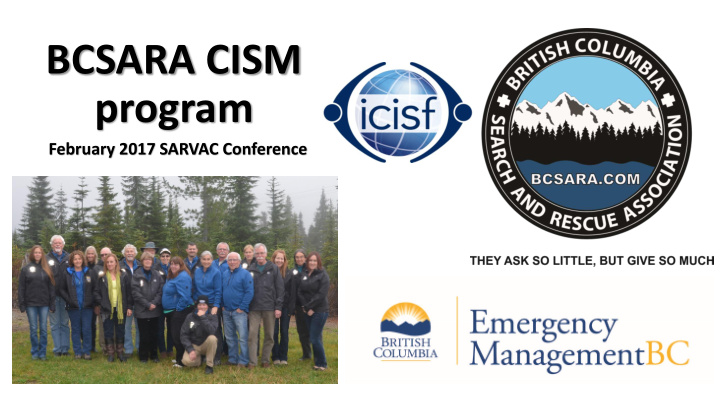



BCSARA CISM program February 2017 SARVAC Conference
CISM team celebrates 10 years of providing supports for all 80 EMBC recognized groups in BC with the support of BCSARA and EMBC
2016 highlights • Stable funding for the team from the $10 million – thank you province of BC and BCSARA!! • Brought on 8 new peers around the province • Record number of callouts • Many multiple response calls • Rise in plane crash related responses
Current Members • Currently 29 active peers ; program uses ongoing recruitment and selection with a priority given to SAR volunteers who have ICISF training • Attrition and retentions rate very similar to SAR volunteers in other disciplines
Training • Peers currently have 2 face to face annual training weekends
N O R T H
Kootenays Okanagan
Lower Mainland
Vancouver Island
Call volume CISM team incidents and interventions 60 50 40 30 20 10 0 2012 2013 2014 2015 2016 incidents interventions
Observable trends • Increase in call outs where search subject completes suicide in a wilderness setting • Increase in body recoveries by SAR groups • Increase in rescue calls involving serious injuries for the subject • The more traumatic the SAR call out is, the more profound the impact on the SAR members and group
Observable trends • Groups that have regular education and awareness sessions use CISM program more frequently • As SAR callouts increase, CISM peer call outs also increase
# of GSAR groups 35 30 25 20 15 10 5 0 2012 2013 2014 2015 2016 # of teams # of volunteers supported in 2015: 295 # of volunteers supported in 2016: 359
Education & Awareness • Ideally happen every 2-3 years for each of the 80 SAR groups • Each peer is given geographically appropriate teams to present to • Best practices • Include spouses, partners, significant others in the presentation • Happen after a new intake of SAR volunteers – critical • After a significant incident EDUCATION & AWARENESS SESSIONS ARE FOUNDATIONAL TO BUILD RESILIENCY FOR SAR VOLUNTEERS
2017 new presentation • Covers new material, more table discussion and activities • Target audiences: new members (MITS) AND experienced members, both with partners/spouses • Topics include: • What does SAR involve? • What is critical incident stress and its impacts? How do SAR members manage it? • How can one prepare for a callout? • What can a SAR member expect, and what can a partner/spouse/family member expect?
So what does Search What is is a critical and Rescue in involve? In Incident? • A critical incident is a SAR 1. Searches call out that is out of the 2. Rescues normal 3. Recovery • EXAMPLES from your 4. Evacuation experiences? 5. Concepts like: 1. Search suspension and termination 2. Dealing with risks and hazards 3. Working within an emergency
What is is Critical In Incident Stress? CRITICAL INCIDENT STRESS IS A NORMAL REACTION TO AN ABNORMAL, STRESSFUL EXPERIENCE • It can affect our thoughts, behaviors, emotions, physical bodies and spiritual beliefs • Each SAR member can have a very different experience with it
SAR will giv ive you the opportunity to confront some uncomfortable topics • SAR will force you to look at your relationship or world view with the following: • Stress, death and strong emotions • You may be: • Searching for a child, someone you know, a suicidal subject
So how does a SAR volunteer manage all ll the ele lements of SAR? • Lots of discussion on what may be a challenge for members, but also how we successfully manage all of this • Talk about the spouse/partner/family contract and a SAR group contract • Focus on resilience and how to build resilience as a SAR member and group
Successes • As CISM requests come in, EMBC is willing to find a way to provide CISM support for SAR volunteers responding to situations outside the normal SAR mandate where volunteers are exposed to critical incident stress • EMBC and CISM peers work collaboratively to provide additional mental health supports to volunteers when WorkSafe coverage is not available or directly attributed to a SAR task – ie external stressors subsequent to a task
Discussion • Are there SAR call outs that groups and members should consider having a no go policy when it relates to critical incidents? How can we define or describe what kinds of critical incidents should be included in that list? • How can we foster a sense of boundaries in our groups and SAR members to reduce the risk of problematic Critical Incident Stress and PTSD?
To arrange an education and awareness session: cism@bcsara.com Q uestions?
Recommend
More recommend